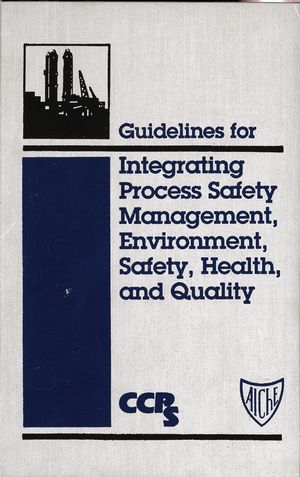Guidelines for Integrating Process Safety Management, Environment, Safety, Health, and QualityISBN: 978-0-8169-0683-3
Hardcover
192 pages
December 1996
 This is a Print-on-Demand title. It will be printed specifically to fill your order. Please allow an additional 10-15 days delivery time. The book is not returnable.
|
||||||
Acknowledgments.
Glossary and Acronyms.
Chapter 1. Introduction.
1.1. The Need for Integration.
1.2. Purpose of Guidelines.
1.3. Scope of Guidelines.
1.4. Approach Used in Guidelines.
1.5. Use of ISO 9000 Standards.
1.6. Exclusions to Scope.
1.7. Intended Audience for Guidelines.
References.
Chapter 2. Securing Support and Preparing for Implementation.
2.1. The Need for Securing Support.
2.2. Identifying Who Will Benefit from Integration.
2.3. Prepare a Preliminary Simplified Plan.
2.4. Management Processes.
2.5. Make Sure to cover All Potential Benefits and Concerns.
2.6. Mission Statement and Goals.
2.7. Define Scope3 of Work and Approach,.
2.8. Selecting Your Integration Team.
2.9. Project Status.
References.
Chapter 3. Assessment of Existing Management Systems.
3.1. The Need for Assessing Existing Management Systems.
3.2. Assess Likely Support or Opposition to Integration.
3.3. Inventory and Asses All PSM. ESH, and Quality Management Programs and Elements.
3.4. Mapping the Management Processes.
3.5. Redesigning the Management Systems.
3.6. Update the Implementation Plan.
References.
Attachment 3.1 Selected Slides from Executive Summary of the Assessment of Existing Systems for Example, Inc.
Chapter 4. Develop a Plan.
4.1. The Need for Developing a Plan.
4.2. Adjust the Preliminary Plan.
4.3. Implementation Strategy.
4.4. Update Benefits and Costs.
4.5. Recast the Plan.
Reference.
Attachment 4.1 Sample Plans/Project Descriptions.
Chapter 5. Integration Framework.
5.1. The Need for Developing an Integration Framework.
5.2. Prioritization of Programs, elements, and Processes for Installation.
5.3. Developing Integrated Systems.
5.4. Continuous Improvement.
5.5. Quality Management Tools.
5.6. Converting Informal Systems.
Reference.
Chapter 6. Testing Implementation Approach.
6.1. The Need for Testing.
6.2. Selecting the Pilot Project.
6.3. Establish Success (and Failure) Criteria.
6.4. Communication.
6.5. Conducting the Pilot.
6.6. Identifying and Correcting Deficiencies in Integration Plan.
Reference.
Attachment 6.1. Sample Pilot Project Advance Communication.
Chapter 7. Tracking Progress and Measuring Performance.
7.1. The Need for Tracking and Measurement.
7.2. Capture Early Successes.
7.3. Measures to Consider.
7.4. Selection and Timing of Measures.
7.5. Customer Feedback.
7.6. Improving Performance.
Attachment 7.1. Sample Monthly Report.
Chapter 8. Continuous Improvement.
8.1. The Need for Continuous Improvement.
8.2. Management Responsibility.
8.3. Auditing the Quality System.
8.4. Product Verification.
8.5. Nonconformity and Corrective Action.
8.6. Personnel (Training).
8.7. Use of Statistical Methods.
Chapter 9. Other Quality Management Systems.
9.1. Introduction.
9.2. Total Quality Management.
9.3. Malcolm Baldridge national Quality Award.
9.4. European Quality Award.
9.5. Deming Quality System.
9.6. ISO 14001.
References.
Chapter 10. Summary.
10.1. Introduction.
10.2. Case Study.
10.3. Summary.
Appendix A. Overview of Definitions from ISO 9004: Quality Management and Quality Systems Elements-Guidelines.
Bibliography.
Index.



